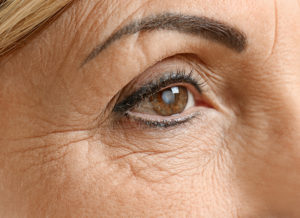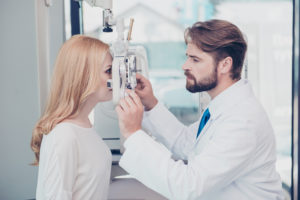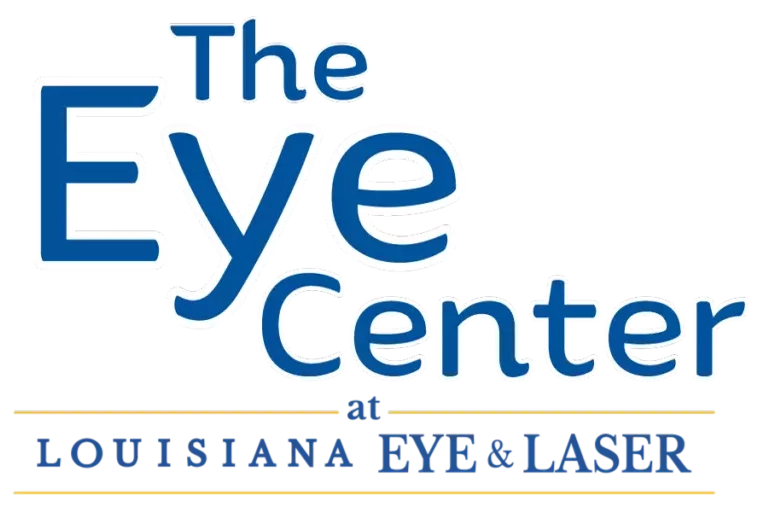
Cataracts are a common condition that slowly cloud the eye, making it difficult or even impossible to see clearly. Although cataract surgery is the only option for treating cataracts, the procedure is quick and simple. Read on below to learn more about cataracts and read some frequently asked questions about cataracts from our patients with answers provided by our doctors.

The majority of the content below has been provided by Dr. Karren Laird Russo, MD, and is medically reviewed for accuracy. Some links have been added to audio transcripts to provide access to relevant resources or information.
Table of Contents:
-
- What is a cataract?
- What causes cataracts?
- How quickly does a cataract develop?
- How do I know if I have cataracts?
- What does my eye doctor look for during an eye exam to know if I have cataracts?
- How is a cataract treated?
- When should cataract surgery be performed?
- What are my options during cataract surgery?
- What are the different lens options for cataract surgery?
- What can I expect after cataract surgery?
- How long does it take to recover from cataract surgery?
- How should I sleep after cataract surgery? Should I sleep in a specific position?
- How soon can I swim after cataract surgery?
- Can some diseases or illnesses cause cataracts at a younger age?
- How does UV exposure lead to increased risk for cataracts?
- How can I prevent cataracts?
- Do cataracts cause headaches?
At Louisiana Eye & Laser, we’re able to help you with all of your eye care needs – including cataracts! If you are looking for an experienced staff with industry-leading technology that’s close to home, look no further than Louisiana Eye & Laser. Schedule an appointment with our team today.

What is a cataract?
Answer provided by Dr. Karren Laird Russo, MD. Transcript included below.
Karren Laird Russo, M.D.:
Cataracts are when the lens of the eye becomes cloudy. The lens of the eye is sort of an M&M shaped part of the eye that is in charge of focusing the light into the back of the retina to help you see better. It is made up of proteins and those proteins continue to develop throughout your lifetime and deposit in the lens. As the proteins get denser, the lens can get cloudy. And when the lens starts to change color and become cloudy, we call that a cataract.
What causes cataracts?
Answer provided by Dr. Karren Laird Russo, MD. Transcript included below.
Karren Laird Russo, M.D.:
So there are a number of things that can cause cataracts. The most common cause of a cataract is age, as we age the epithelial cells in the lens itself continue to produce protein. And these proteins make the actual lens color, denser, and denser, and more yellow. So the most common cause of the cataract is just the aging lens. Other things can cause cataracts as well. Certain medicines like steroids, trauma can cause cataracts, and some children are born with congenital cataracts, and those can be caused by different infections in utero. So there are a number of causes of cataracts, but by far, the most common is aging.

How quickly does a cataract develop?
Answer provided by Dr. Karren Laird Russo, MD. Transcript included below.
Karren Laird Russo, M.D.:
So it depends an age related cataract can develop quite slowly, over many, many years. A traumatic cataract can develop almost instantaneously with the trauma. And of course, congenital cataracts you’re born with them. So depending on the cause of the cataract that’s how fast they can develop, but in general, the age related cataracts are the slowest. Those caused by different medicines like steroids are the next slowest to develop. And then the fastest would be something along the lines of trauma.
How do I know if I have cataracts?
Answer provided by Dr. Karren Laird Russo, MD. Transcript included below.
Karren Laird Russo, M.D.:
Well, cataracts typically cause blurred vision. And so the only way to know whether or not your blurred vision is caused by cataracts is to get an eye examination.

What does my eye doctor look for during an eye exam to know if I have cataracts?
Answer provided by Dr. Karren Laird Russo, MD. Transcript included below.
Karren Laird Russo, M.D.:
When you come in for an eye examination, we check your vision. We dilate your eyes so that we can see the actual lens of the eye, because as I stated before, the lens of the eye actually sits behind the iris, which is the colored part of your eye. So it’s necessary to dilate your iris so that we can get a good look at the actual lens of your eye. After the eyes dilated, we use a slit lamp, which is a microscopic device with a very thin light source that allows us to look at the lens of the eye to tell whether it’s discolored or has had any cataractive changes in it.
How is a cataract treated?
Answer provided by Dr. Karren Laird Russo, MD. Transcript included below.
Karren Laird Russo, M.D.:
Many people have cataracts, but it may not be actually affecting their vision. Really, after the age of 40, most people have some sort of color change to their lens. It’s just natural, but most people still have very good vision and are not affected by having cataracts. So the first course of action would be, if there’s any change, would be to see if glasses or contact lenses would correct the vision. If glasses or contact lenses will not correct vision and the person or the patient is having significant visual difficulties performing their activities of daily living, whether it’s driving, or reading, or watching TV, then we offer a cataract surgery to remove the cloudy lens and replace it with a clear lens implant.

When should cataract surgery be performed?
Answer provided by Dr. Karren Laird Russo, MD. Transcript included below.
Karren Laird Russo, M.D.:
Cataract surgery should be performed when patients are unable to perform activities that they enjoy, including reading, driving at night, watching TV, if they’re not able to do their activities of daily living that they enjoy and need to do to have a productive life, and we are not able to correct their vision non surgically with glasses or contact lenses, then it’s time to consider cataract surgery.
What are my options during cataract surgery?
Answer provided by Dr. Karren Laird Russo, MD. Transcript included below.
Karren Laird Russo, M.D.:
So once a person has decided, and their physician agrees that it is appropriate to have cataract surgery, there are a number of different options for the type of cataract surgery the patient can have, as well as the type of lens implant a patient may choose to put into their eye. So before anyone has cataract surgery we do a number of measurements. We measure the length of the eye and the shape of the eye checking for any astigmatism. Additionally, we check for any comorbid disease, such as diabetic retinopathy, macular degeneration, corneal diseases that could inhibit a perfect visual outcome after cataract surgery, so that everyone is on the same page of what a person may expect after surgery.
So once the eye has been thoroughly examined the patient and the physician discuss what surgical options are available for their particular eye, we have the traditional way of removing cataracts, including using a diamond blade to make incisions in the cornea and manually making what’s called a capsulorrhexis. A capsulorrhexis is where we make a small opening in the anterior aspect of the lens in order to access the nucleus, the central part of the lens. When we do cataract surgery, we remove the nucleus, we remove the central part with ultrasound. We break it apart and it’s emulsified and removed with the phacoemulsification instrument.
Once that’s done, the implant of choice is folded and put into the capsule of the original lens. That capsule is what holds the lens in the eye in the proper position. The incision in the eye, as well as the capsulorrhexis can also be performed by a laser. The laser can also do a pre-chop of the nuclear component of the lens, which can make the lens easier to remove. So those steps can be done manually or with a laser. So that is one decision a patient can make is whether to have manual cataract surgery or laser assisted cataract surgery. Now notice I said, laser assisted cataract surgery, in that the laser doesn’t do the cataract surgery completely, incisions still have to be made. And the phacoemulsification instrument is still used to actually remove the nucleus from the eye. Once the implant of choice is placed into the eye, the patient generally goes back to the recovery room and there we review postoperative instructions with them.

What are the different lens options for cataract surgery?
Answer provided by Dr. Karren Laird Russo, MD. Transcript included below.
Karren Laird Russo, M.D.:
There are different types of implants a patient can choose to have put into their eye. Some are mono focal lenses that give you good distance vision, but you will still need reading glasses. If a person has astigmatism, which means their corneal shape is not perfectly dome shaped, it shaped more like a football than a baseball. There is a type of implant called a toric lens that will help correct that to give you better uncorrected distance vision.
There are also implants that are multi-focal implants that can give you distance vision and some near vision. There are multi-focal toric implants that will give you distance vision, near vision, and also correct for your astigmatism. Another option when we do cataract surgery is to have an inter-operative measurement of the length of your eye and the shape of your cornea. We do this preoperatively, but it can also be done after the cataract has been removed to give us the most accurate measurement of the eye so that we have the most accurate outcome postoperatively.
What can I expect after cataract surgery?
Answer provided by Dr. Karren Laird Russo, MD. Transcript included below.
Karren Laird Russo, M.D.:
So after cataract surgery, we have you use typically three different types of drops. We have you use an antibiotic drop, a non-steroidal anti-inflammatory drop, and a steroid drop. All three of these drops are used to help prevent infection, or inflammation, or swelling in the eye postoperatively. You will use these drops for one to three weeks, depending on the drop after surgery. Additionally, we ask for the first week that you wear a shield over the operative eye so that you don’t accidentally wake up, and rub your eye, and cause a problem. And we also asked that first week that you not do any heavy lifting or bending while the eye is healing, you don’t want to get the eye dirty because that is the time when potentially you could get an infection, but you can drive and do most everything else right after surgery.
How long does it take to recover from cataract surgery?
The recovery process varies from patient to patient, but most people heal within a few days to a few weeks. Immediately after cataract surgery, many patients experience blurred or wavy vision as well as red and bloodshot eyes. While some patients report clear vision within hours, everyone is different. Other patients can take a few weeks to feel completely normal. All patients should be cautious following surgery, but most people can comfortably watch TV, work on a computer and shower or bathe within a few hours of surgery. Your surgeon will schedule follow up appointments as necessary following your surgery.
How should I sleep after cataract surgery? Should I sleep in a specific position?
Answer provided by Dr. Karren Laird Russo, MD. Transcript included below.
Karren Laird Russo, M.D.:
As long as you’re wearing the shield for that first week, you really don’t have to worry about sleeping in any particular position. It is optimal, if you can sleep on the side opposite from the operative eye, but as long as you’re wearing the shield, you’re safe.
How soon can I swim after cataract surgery?
Answer provided by Dr. Karren Laird Russo, MD. Transcript included below.
Karren Laird Russo, M.D.:
I would wait at least two weeks after cataract surgery before going swimming.
Interviewer:
Why is that? Why do I need to be extra careful about swimming?
Karren Laird Russo, M.D.:
There’s an incision in the eye and we don’t use sutures. So it is particularly susceptible to bacteria, and swimming and pool water has a lot of bacteria, and you’re bathing your eye in that bacteria. So it would just increase your risk for infection.
Can some diseases or illnesses cause cataracts at a younger age?
Answer provided by Dr. Karren Laird Russo, MD. Transcript included below.
Karren Laird Russo, M.D.:
Yes, diabetes, particularly if it’s uncontrolled, can lead to cataracts at a younger age. Smoking can lead to cataracts at a younger age, different auto immune diseases, particularly ones that cause you to use steroids excessively can lead to cataracts at a younger age. Excessive UV exposure can cause cataracts at a younger age. I do seem to find that truck drivers, and I think it is because of the UV exposure, seem to have cataracts at a younger age. So there are a number of things that can cause cataracts to develop sooner than they normally would.

How does UV exposure lead to increased risk for cataracts?
Answer provided by Dr. Karren Laird Russo, MD. Transcript included below.
Karren Laird Russo, M.D.:
Well, it tends to increase antioxidants in your eye. I mean the oxidative, not antioxidants, but the oxidation in the lens, and that can cause changes to the lens fibers, and the protein and cause early cataracts. So taking antioxidants, vitamins, eating fruits and vegetables, and wearing sunglasses can all help prevent cataracts.
How can I prevent cataracts?
Answer provided by Dr. Karren Laird Russo, MD. Transcript included below.
Karren Laird Russo, M.D.:
There’s no way to ultimately prevent cataracts if you live long enough, but you can certainly mitigate damages from environmental factors that could make them develop earlier in life, such as smoking, excess exposure to UV light, and taking unnecessary medicines, eat lots of fruits and vegetables.
Can Cataracts Cause Headaches?
Do you have headaches that you suspect are being caused by cataracts? Many of our patients have asked us if cataracts could be the possible cause of their headaches. The answer is yes, cataracts can cause headaches if not treated properly. Cataracts typically get worse over time and left untreated, a cataract will continue to obscure your vision. The vision obstruction will cause your eyes to strain themselves which can cause intense migraines and headaches. Keep in mind it is not the cataracts themselves that are causing the headaches, but the cataracts that are causing visual strain that can cause headaches.

Can My Cataracts Come Back After Surgery?
One of the most common questions our doctors are asked by cataract patients is “Can my vision get blurry again after cataract surgery?” Their fear is that after a successful cataract surgery, a new cataract will form. Luckily this is not the case. Once a natural clouded lens has been removed, a new cataract can not form in the artificial one. There are some rare cases where a patient can experience posterior capsule opacification (PCO) which is sometimes referred to as a second cataract. This is when the capsule that holds the new artificial lens develops a layer of scar tissue that can cause some obstruction that can make the vision blurry. Thankfully, if one does develop PCO, it can be easily corrected with a quick in-office procedure called a YAG capsulotomy.

Visit Louisiana Eye & Laser
After more than 40 years of service, we’ve helped countless patients with all of their eye care needs. If you have cataracts or are concerned about cataracts, come visit one of our 14 convenient locations for an exam. Cataract surgery is one of the most common optical surgeries available and our top-notch facilities and staff will make your cataract surgery a breeze. At Louisiana Eye & Laser you can see the difference!




